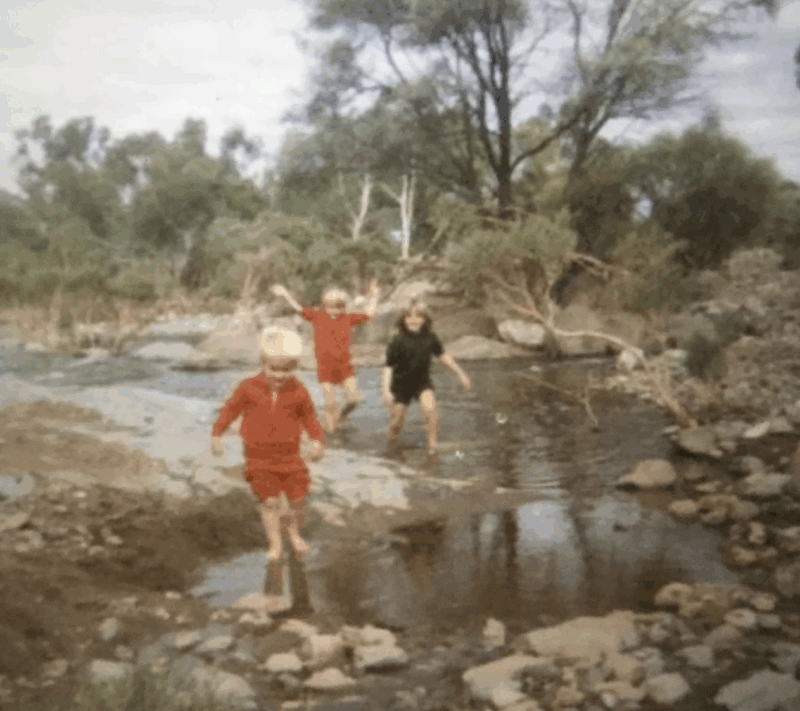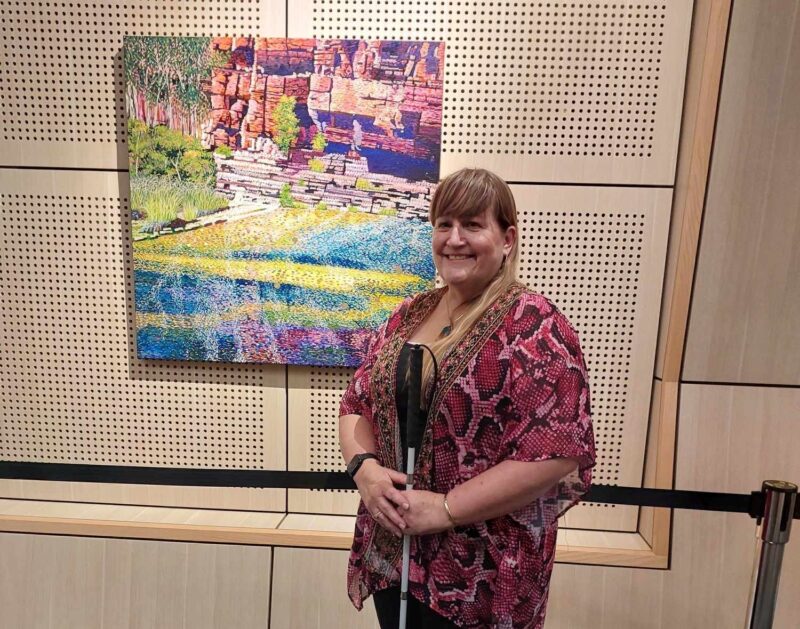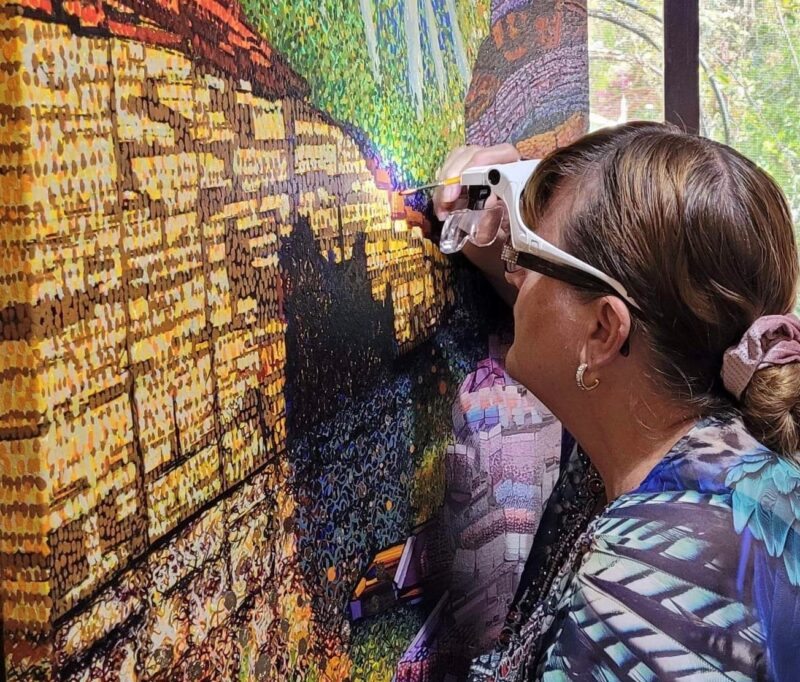In the quiet bushland of Mundaring, Western Australia, lives a remarkable legally blind artist whose work is as layered and luminous as her life story. Ericka Baker’s latest painting – nine months in the making – has already won a position in the International Arts Award Book and the 101 Artbooks Landscape edition. Ericka herself has been submitted for an Emerging Artist Award. But for Ericka, this artwork is more than just a canvas. It’s a tribute to her late husband, a reflection of her childhood in the Pilbara, and a powerful expression of resilience and inclusion.
A childhood etched in colour
Born in Whyalla South Australia, Ericka moved to Tom Price in the Pilbara at age three after her father got a job with Hamersley Iron. Ericka has been vision impaired since birth, caused by congenital nystagmus after her mother contracted German measles during pregnancy. She now has less than 4% vision in one eye and just over 4% in the other. Before moving to Tom Price, Ericka’s parents would take her to the Royal Children’s Hospital in Adelaide for treatment of her eyes. After moving to the Pilbara, vision services were difficult to access, and technology was not as advanced as it is today. As a child unable to see the blackboard clearly, she often drifted into her imagination, doodling and dreaming of the vibrant red earth and deep freshwater pools of Karijini National Park.
“My dad used to take us kids on family trips to Karijini. It was a beautiful, stark landscape full of risks, but he never treated me differently. I learned to find my way around independently, and that freedom shaped me,” Ericka recalls. “I’d collect stones and crush them to make paint. I wanted to capture the earth’s rich reds, earthy browns, and that deep, sacred blue of the water.”

Finding her way through art
Determined to pursue education despite the challenges of living in a remote community, Ericka completed Years 11 and 12 by correspondence. Staying in Tom Price wasn’t really an option for Ericka, as there wasn’t much work in the small town outside of mining. The mining industry wasn’t a career path for people with vision impairment, and deep down she longed for a more intellectual path.
After high school, Ericka moved with her parents to Capel, a small town in the Southwest, which proved to be equally isolating. She missed her friends in Tom Price and found a similar lack of transport and job opportunities, so Ericka leaned into her childhood passion for art.
In 1993, she completed an Advanced Certificate in Art and Design through TAFE. Around this time, she met her husband Stephen, who instantly recognised her talent. “Stephen believed in me more than I believed in myself,” she says. “He secretly enrolled me in an art course at Edith Cowan University, and I only found out when I got an interview invitation. I was stunned.”
With the support of the Sue Knox Scholarship and a dedicated reader to dictate the course work, Ericka graduated in 2008 with a Bachelor of Visual Arts, majoring in Printmaking. She later completed a Diploma of Photography in 2017 and studied Drawing Nature, Science and Culture. Inspired by the Impressionists like Monet, especially his works from his years experiencing cataracts, Ericka developed a style that blends memory, emotion, and sensory experience.
“I love how Monet painted light and colour when his vision was failing. It resonates with me. I paint what I feel, not just what I see.”
Painting through pain and memory
Ericka’s creative process is deeply physical and emotional. Her eyesight causes fatigue and frequent migraines – some lasting up to 11 days. But rather than letting the pain stop her, Ericka channels it into her art.
“I paint my migraines as I feel them. The aura of colour, the distortion – it’s all there on the canvas. It helps me recover. It’s like I’m releasing the pain.”
Using magnifying glasses with built-in lights, she works close to the canvas, building intricate landscapes from memory. Her latest piece, a painting of Fern Pool in Karijini National Park, is a tribute to her late husband Stephen, who passed away in 2021.
“Stephen loved Karijini as much as I did. This painting is for him. It’s where we felt most connected to each other and to the land.”
Ericka’s work is more than visual – it’s tactile and inclusive. She incorporates braille into her paintings, creating a shared experience for people with sight, low vision, or no vision.
“I want people to feel the story, not just see it. Braille lets me share my world with others from a tactile perspective. One day I’d love to create a dark room filled with paintings where the braille lights up when touched – bringing accessibility and emotion together.”
A career of creativity and advocacy
Encouraged by her husband to pursue art full time, Ericka’s first exhibition, From the East to the West, was held in Bowral, NSW in 2018. She later partnered with Willow Industries to paint cricket bats and skateboards, auctioning them to support children with autism. Her solo exhibition Secrets of Gold debuted in 2021, and she’s been a finalist in the Bluethumb Landscape Award.
In 2024, her work featured in the AccessAbility Exhibition at the Red Earth Arts Precinct in Karratha. She’s also been selected for the Arts to Heart Projects, supporting women in the arts, and will be featured in the International Artist Award Book, as well as the 101 Artbook: Landscape Edition, and has been entered into the 100 Emerging Artworks of 2025, with results expected later this year.
“As an artist inspired by the rugged beauty of the Pilbara landscape, I explore themes of resilience, fragility and isolation in my work. My experiences with disability have deeply influenced my art and I aim to promote great inclusion through my unique perspective. By incorporating braille into my paintings, I invite viewers to engage with my work on multiple levels, fostering a deeper connection and appreciation for the complexities of the human experience.”

Support from VisAbility
After Stephen’s passing, Ericka turned to VisAbility to help regain her independence. With support from Occupational Therapist Rachel, she’s been equipped with assistive technology that’s transformed her daily life.
“I have apps on my iPad and phone that help me enlarge text and read labels. My Onyx OCR machine is a game-changer. Now I can read books, letters, bills, and make them big enough to see without my magnifying glasses.”
Mobility training with a white cane has been life-changing. “I used to walk staring at the ground to avoid hazards. Now I can walk looking ahead. It seems a small change but it’s saved my neck from a lot of pain and discomfort.”
She’s also exploring Ray-Ban smart glasses with AI assistance and has begun learning braille with support from VisAbility’s team. “Josef from the Client Experience Team is helping me to access braille classes with Manny. I’m excited to add it to my art in new ways.”

A vision impaired artist leading with heart
Ericka Baker is not just a vision impaired artist – she’s a visionary. Her work speaks to the soul, drawing viewers into the landscapes of her memory and the emotions of her lived experience. Through innovation, resilience, and a deep love for the Pilbara, she’s creating art that’s inclusive, meaningful, and unforgettable. It’s no surprise she’s taking out countless awards in the process!
“Art is my voice. It’s how I connect, how I heal, and how I honour the people and places that shaped me.”
You can view Ericka’s art on her Instagram accounts @Sunspurstudio and @Wild_beautiful_insanity
To learn more about how VisAbility supports people with low and no vision across Western Australia, visit www.visability.com.au
